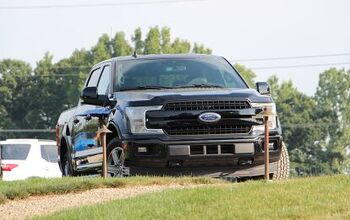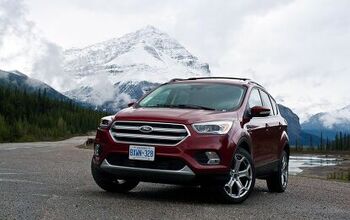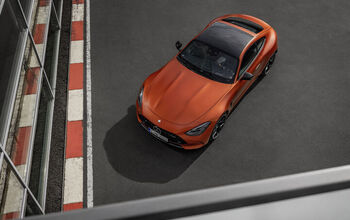2011 Ford Explorer Review - First Drive [Video]

Do you know what the difference between a crossover and an SUV is? Maybe not, but chances are that if you described what you’re looking for in an every day utility vehicle, you’d actually be talking about a crossover.
FAST FACTS
| 1. A new 3.5L makes 290-hp and 255 ft-lbs of torque, just 2-hp short of the old V8 but 32 percent better on gas. |
| 2. The 2011 Explorer boasts best-in-class fuel economy of 17/23-mpg (city/hwy) for AWD models and 17/25-mpg for FWD models. |
| 3. Maximum towing capability is down significantly and well below the competition at 5,000 lbs. |
| 4. A new car based chassis delivers vastly improved on-road driving dynamics. |
| 5. Ford’s Terrain Management AWD selector lets you easily choose a setting for the driving environment, be it Normal, Mud, Snow or Sand. |
| 6. Pricing starts at $28,995 and rises to $31,995 for XLT models and $37,995 for the Limited trim level. For AWD versions, tack on an extra $2,000. |
The distinction between the two is actually quite simple, with an SUV using a truck chassis and a crossover underpinned by a car chassis. More importantly, however, is what this means to how a vehicle handles, drives, what kind of fuel economy it gets and its overall functionality.
The original Explorer was a tremendous success for Ford, delivering what the automaker perceived consumers wanted. But over time car shoppers either changed what they wanted or, more likely, realized what they really were looking for. And despite their love for the Ford SUV (buying 6 million of them), there were a few things they’d change if they could.
While off-road capability and towing are important, Ford canvassed Explorer owners and other new car shoppers to discover that top among the list of demands are things like ride quality, handling and fuel economy.
In the past, meshing these two conflicting lists has brought about ‘soft-roaders,’ first in the compact class and then in the mid-size segment, with a significant bias towards on-road use. The large vehicle segment, where the Explorer competes, is different and true utility is valued much higher. That being said, Ford did its research in transforming the Explorer from SUV to crossover, attempting to limit the compromises inherent in this change.
To find out just what kind of a job they did, we were invited to the launch of the all-new Explorer in San Diego to test the vehicle’s varied capabilities.
EXPLORER CROSSOVER SHINES ON-ROAD
As a crossover, it’s a massive success. The Explorer drives far more like a car than its SUV rivals, which include segment heavyweights like the Toyota 4Runner and Jeep Grand Cherokee.
It’s smooth on the highway and composed in the corners, at all times aided by a feel from the driver’s seat that has an inherent familiarity to it. The pedals are quick to react in car-like fashion (much unlike the Jeep), the steering is direct and the vehicle follows through with far less roll that one would expect by looking at the size of it.
Get the Flash Player to see this player.
Even the electric power steering system is quite good, without the initial vagueness these systems have become known for.
Compared to the previous Explorer, or even to modern rivals, this new crossover feels smaller (despite having grown in size) and is more, dare we say it, enjoyable to drive.
As for fuel economy, Ford is continuing its commitment to be a leader, with the new truck tossing its V8 in favor of a V6. While there is no replacement for displacement, a little engineering certainly makes a big difference and the new 3.5-liter engine, which first debuted in the new Mustang sporting twin variable vale timing, makes just 2-hp less than the old V8, while offering a 32 percent improvement in fuel economy. Compared to the V6, it’s 25 percent more efficient, while boasting a total of 290-hp and 255 ft-lbs of torque.
Next year, Ford will offer an EcoBoost turbocharged 4-cylidner engine in the truck as well, offering even better fuel economy, with similar power.
In its current layout, power certainly isn’t lacking and fuel economy is best-in-class with 25-mpg on the highway for front drive models and 23-mpg highway for AWD versions, with both getting 17-mpg city. Ford estimates that this alone will save customers anywhere from $500 to $1,000 a year in fuel costs.
Yet another way the new Explorer improves on the old is its reduced noise, with less sound from the road entering the cabin, allowing for occupants to more easily hold a conversation.
OFF-ROAD CAPABILITY NOT FORGOTTEN
But with its newfound asphalt expertise come the off-road drawbacks. Ford isn’t claiming the new Explorer is more capable or even as capable as the old truck. Instead the folks at the Blue Oval point to their research, showing that the 2011 model is purpose built to meet the needs of the vast majority of shoppers, while still offering enough real SUV utility to remain on the shopping lists of those ‘just in case’ customers who may not ever need to drive off road, but who want to know they’re prepared… just in case.
One immediate drawback is the tow rating, with a max capability of 5,000 lbs, down 2,100 lbs from the previous model and short just as much from its rivals. Ford believes this won’t be a deal breaker, however, with market research showing that only 0.04 percent of all past Explorer drivers require more than 5,000 lbs of towing capability and don’t already own another vehicle (like a heavy duty pickup) that can do the job.
As for true off-road capability, Ford arranged for us to do a little off-roading; an exercise also intended to display the ‘drive smart’ technology involved in the Explorer’s new Terrain Management AWD system.
Again, the Explorer impressed. The truck’s 8-inch ground clearance provides more capability than needed, with the prepped off-road course significantly more challenging than any drive to the cottage we’ve ever experienced.
As for those looking for maximum off-road capability, look elsewhere says Ford. In their study of past Explorer owners, none used the vehicle for rock climbing and so the more extreme off-road capability was ignored in order to help create that excellent on-road feel.
Driving on longer sections of uneven trail running trough a field – the kind you might see a truck like the Explorer speeding along in a tv commercial – it delivered a composed ride quality on less than perfect terrain, at modest speeds of about 40-mph.
When the road gets rough it’s time to utilize the truck’s Terrain Management settings, including the Mud and Ruts setting as well as the Hill Descent Control, which instead of using low gears, is a rather crude way of maintaining speed down hill using the brakes. Yet as rudimentary as it feels, the system works, easily handling a slope so steep you’d almost expect the truck to roll end-over-end down to the bottom.
As one of Ford’s ‘drive smart’ technologies, the Terrain Management system uses the vehicle’s traction and stability control programs and integrates both steering and throttle response to deliver the best capability depending on the situation. Opting to do away with buttons marked 4HI and 4LO, it instead features a dial on the center console with four easily marked settings for different types of driving environments, so suburban housewives and off-roading enthusiasts alike both know what setting to use to tackle any low-grip situation.
Having already used the normal on-road setting as well as the Mud and Ruts setting for our off-road excursion, Ford arranged some fun in a sand pit to demonstrate the difference between the Sand and Snow settings. With the snow mode engaged the truck limits throttle, dials up the traction control and then takes them both to the extreme limits of boring (and safety) when you add in a lot of steering. Conversely, the Sand mode limits the invasiveness of the traction control and allows for plenty of throttle and steering, so you can hoon-it-up, driving the truck with the rear tires.
EXPLORING THE INTERIOR: HIGH-TECH MEETS LOW GRADE
There’s more to the new Explorer than just the crossover conversion. In fact, there’s a lot more, including an all new interior that features the MyFord Touch user interface – which comes as standard on the mid-trim $31,995 XLT model. Ford debuted this system on the 2011 Edge, but we’ve now had more time to fiddle with it and while the learning curve is steep at first, we’re already getting used to it. Ford advertises you can access all major vehicle functions with any one of the three interfaces, still, we found that for the most complex settings the 8-inch touch screen works best, with the hand controls and gauge-integrated LCD screens preferred for simple adjustments like changing the radio station or upping the temperature, while the SYNC system is better-off ignored – we were several miles into our drive before it correctly understood our commands to set the temperature.
Upgraded for 2011, the SYNC system does get one new feature that’s certain to be attractive to a lot of shoppers. By inserting your USB broadband modem from your laptop into the USB port in the dash, it transforms the entire car into a WiFi hotspot so passengers can log in through a secure connection to get online. It doesn’t cost any extra, but you do have to pay for a SYNC equipped model and you’re already paying for that broadband stick.
Arguably the biggest benefit to MyFord Touch is perceived value, with the glossy 8-inch screen on the center stack and two small screens on the gauge cluster giving a luxury feel well beyond the Explorer’s price point.
In start contrast to this, however, is a lot of the Explorer’s interior. Many of the materials may be soft touch, but they still look like cheap hard plastic. The gap between the doors and the dash is literally wide enough to fit your fingers in, the 5-way steering wheel mounted controls are the same flimsy plastic as in the Fiesta and the ‘Explorer’ badged door sill kick plates try for rugged, but just come off as cheap. The new Explorer’s $28,995 base price is actually $1,000 less than the outgoing model, so with all the advances it seems Ford chose the interior trim as the main place to cut costs.
As for the fancy button-less center console, it still manages to look like a big piece of gray plastic unless you opt for the top level Limited trim that includes a stylish piano black dash, complete with a 12-speaker Sony audio system and a $37,995 sticker price.
Limited models also come with such luxuries as leather seats with heated front seats, a 10-way power driver’s seat, 6-way power passenger seat, dual zone climate control, Intelligent Access with push-button ignition, remote start, a rear view camera and the world’s first inflatable second row safety belts, which distribute the force of the seatbelt on the body 5-times that of traditional belts to better protect second row passengers who, because of their youth or old age, are more susceptible to chest injuries in accidents.
Another important safety feature added to the 2011 Explorer is Curve Control, which acts like a more extreme version of stability control to detect when a vehicle is entering a corner too fast and applies the brakes five times quicker and harder to drop speed by as much as 10 mph in under a second. Optional safety features can also be had, including a collision warning system as part of Adaptive Cruise Control; a Blind Spot Information System, Cross Traffic Alert, a Back-Up Camera and MyKey, that lets a key be programmed to limit things like speed and stereo volume while ensuring traction control can’t be turned off.
THE VERDICT
It’s no secret that most people who buy utility vehicles never actually put them to use, so Ford has built a truck that looks the part and, for the most part, acts it, for those who think they want an SUV, but who actually want a crossover. But what Ford’s plan doesn’t account for is the much larger group who buy vehicles like the Explorer not because they need the utility, but because they think they need it.
According to Ford, only 15 percent of Explorer owners ever tow and just 17 percent ever drive their truck off-road. Still, rather than abandon that small group (and the much larger percentage who think they might just tow or off-road some day), they created a crossover that will do the vast majority of the dirty work of the old model in order to bring back the 140,000 current Explorer owners who are looking for a new car each year, while attracting other utility vehicle shoppers to one of the most recognizable nameplates in the business.
Put to the test, the new Explorer (a crossover, not an SUV) is a tremendous improvement for the majority of buyers who don’t use its truck-like utility. And for those who do, or think they might, it’s capable enough to meet the vast majority of your needs – be they real or perceived.
The 2011 Explorer even looks like a real truck – though it’s hardly as handsome as its Jeep rival. And despite its more efficient-minded design and lighter curb weight, it’s actually both longer and wider than the outgoing model, plus it boasts more cargo room with a best-in-class 80.7 cu.-ft., and continues to be a 7-seater – just in case you need those seats some day.
While so many modern vehicle reviews focus on a seemingly never-ending stream of compact cars and 40-mpg claims, the utility vehicle segment actually makes up a solid 32 percent of all vehicle sales in the U.S. And with that number growing, the Explorer is poised to make a real comeback, carrying on much of the utility, without the drawbacks.
RELATED READING
2011 Jeep Grand Cherokee Review: First Drive
2011 Dodge Durango Review – First Drive
2010 Toyota 4Runner SR5 Review
2010 Subaru Outback 3.6R Review
2010 Nissan Pathfinder SE 4×4 Review
LOVE IT
- Car like drive
- Much improved, segment-leading fuel economy
- Easy to understand and use Terrain Management
- MyFord Touch adds perceived value
LEAVE IT
- Low grade interior trim
- SYNC still an often-frustrating experience

With AutoGuide from its launch, Colum previously acted as Editor-in-Chief of Modified Luxury & Exotics magazine where he became a certifiable car snob driving supercars like the Koenigsegg CCX and racing down the autobahn in anything over 500 hp. He has won numerous automotive journalism awards including the Best Video Journalism Award in 2014 and 2015 from the Automotive Journalists Association of Canada (AJAC). Colum founded Geared Content Studios, VerticalScope's in-house branded content division and works to find ways to integrate brands organically into content.
More by Colum Wood






































Comments
Join the conversation